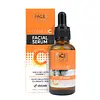What's inside
What's inside
 Key Ingredients
Key Ingredients

 Benefits
Benefits

 Concerns
Concerns

 Ingredients Side-by-side
Ingredients Side-by-side

C15-19 Alkane
SolventSimmondsia Chinensis Seed Oil
EmollientOctyldodecanol
EmollientCannabis Sativa Seed Oil
EmollientSqualane
EmollientCoffea Arabica Seed Oil
MaskingPropolis Extract
Skin ConditioningGlycine Soja Oil
EmollientTocopherol
AntioxidantAscorbyl Tetraisopalmitate
AntioxidantBeta-Carotene
Skin ConditioningDaucus Carota Sativa Root Extract
Skin ConditioningDunaliella Salina Extract
Skin ConditioningBeta-Sitosterol
Emulsion StabilisingSqualene
EmollientCitrus Paradisi Peel Oil
MaskingLimonene
PerfumingC15-19 Alkane, Simmondsia Chinensis Seed Oil, Octyldodecanol, Cannabis Sativa Seed Oil, Squalane, Coffea Arabica Seed Oil, Propolis Extract, Glycine Soja Oil, Tocopherol, Ascorbyl Tetraisopalmitate, Beta-Carotene, Daucus Carota Sativa Root Extract, Dunaliella Salina Extract, Beta-Sitosterol, Squalene, Citrus Paradisi Peel Oil, Limonene
Ingredients Explained
These ingredients are found in both products.
Ingredients higher up in an ingredient list are typically present in a larger amount.
Limonene is a fragrance that adds scent and taste to a formulation.
It's found in the peel oil of citrus fruits and other plants such as lavender and eucalyptus. The scent of limonene is generally described as "sweet citrus".
Limonene acts as an antioxidant, meaning it helps neutralize free radicals.
When exposed to air, oxidized limonene may sensitize the skin. Because of this, limonene is often avoided by people with sensitive skin.
The term 'fragrance' is not regulated in many countries. In many cases, it is up to the brand to define this term. For instance, many brands choose to label themselves as "fragrance-free" because they are not using synthetic fragrances. However, their products may still contain ingredients such as essential oils that are considered a fragrance.
Learn more about Limonene